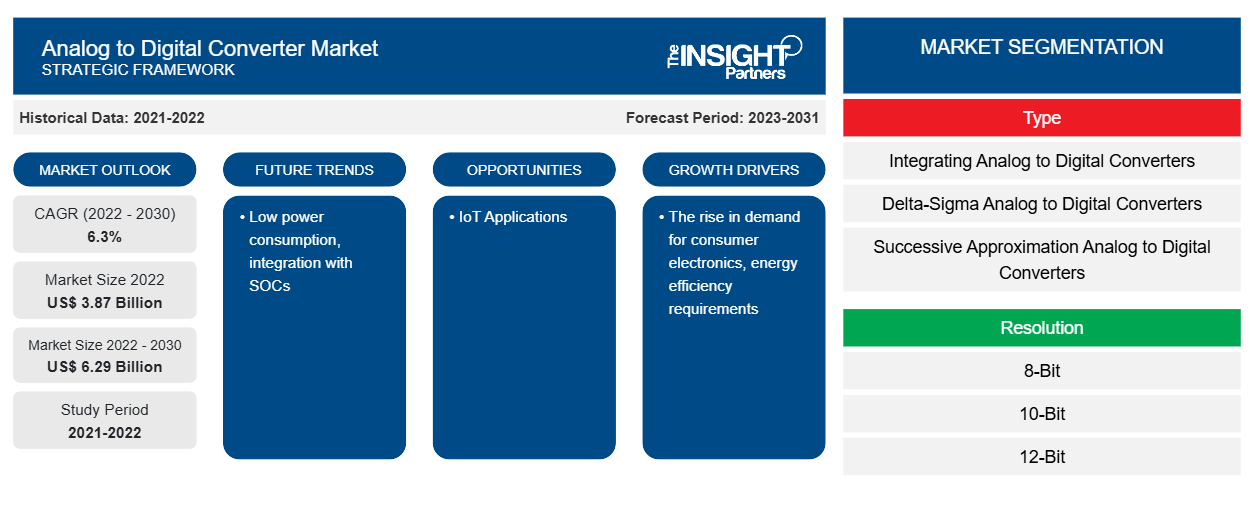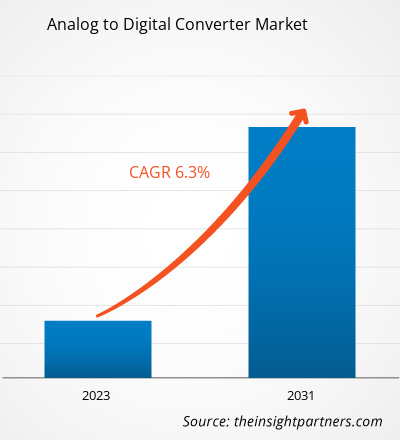The analog to digital converter market size is projected to reach US$ 6.29 billion by 2030 from US$ 3.87 billion in 2022. The market is expected to register a CAGR of 6.3% during 2022–2030. Low power consumption and integration with SOCs are likely to remain a key trend in the market.
Analog to Digital Converter Market Analysis
Data converters play a critical role in the enablement of high-resolution content for ultra-high-quality playback music experience. These converters filter unwanted noises and ensure low power consumption to maximize the battery life of devices such as headphones. The manufacturer witnessed increasing demands for faster conversion speed and higher resolution. Several developments are underway in the analog to digital converter market to attain higher accuracy, wider dynamic range, and effective compatibility. Advancements in new oversampling techniques have prominently helped in the cost reduction of converters. According to many manufacturers, the demand for higher resolution among data acquisition system designers is attributed to their aim to utilize each bit of the resolution. Higher-resolution converters provide critical and additional details about the data.
Advancements in communications, such as the rollout of 5G, are predicted to open up new application areas for analog to digital converters. The analog to digital converter (ADC) is integrated into 5G base stations for converting analog values into digital values for users’ benefit. Countries such as India, China, the US, Germany, and Brazil are experiencing a rise in the 5G trials. Further, ADCs are also used in the automotive sector and have applications in telematics systems and LiDAR. ADCs are required in myriad industries, such as semiconductor, automotive, telecommunication, and industrial. They are also used for imaging charge-coupled devices (CCD), including scanners, digital cameras, camcorders, and test instrumentation.
Analog to Digital Converter Market Overview
Analog-to-digital converters (ADCs) help convert data from analog signals received from environmental phenomena into digital signals. The entire conversion includes several steps, such as sampling, quantization, and coding. ADCs are the essential components as analog values must be converted to digital values for further processing. Various types of ADCs present in the market include simultaneous or flash ADCs, tracking-type ADCs, counter-type ADCs, successive approximation type ADCs, sigma-delta ADCs, and single-, dual-, and multi-slope ADCs. These converters find applications in digital signal processing (microcontrollers, TV tuner cards, digital storage oscilloscopes), scientific instruments (digital imaging systems, temperature sensors, radar systems), and digital audio (sound recording, digital audio workstations, and pulse-code modulation).
Customize This Report To Suit Your Requirement
You will get customization on any report - free of charge - including parts of this report, or country-level analysis, Excel Data pack, as well as avail great offers and discounts for start-ups & universities
Analog to Digital Converter Market: Strategic Insights

-
Get Top Key Market Trends of this report.This FREE sample will include data analysis, ranging from market trends to estimates and forecasts.
Analog to Digital Converter Market Drivers and Opportunities
Rise in Demand for Consumer Electronics to Favor the Market
The growing urbanization and rising disposable income have been the major enablers of the proliferation of the electronics industry. According to the US Bureau of Economic Analysis, in March 2023, disposable personal income (DPI) in the US rose by 0.5% in February 2023 compared to January 2023. The growth in people's disposable income contributes to the strong purchasing power, which bolsters the sales of television sets, microwaves, and other consumer electronics. Further, a rise in government initiatives to boost domestic production output plays a crucial role in boosting the electronic industry in different countries. According to the Ministry of Electronics & IT, in March 2023, Indian electronics manufacturing is expected to reach US$ 300 billion by 2025–2026. The government's strategic steps and initiatives favor the progress of the electronics industry. Under India’s National Policy on Electronics 2019 (NPE 2019), special schemes are introduced for large-scale electronics manufacturing.
The ever-increasing demand for consumer electronic devices such as smartphones, tablets, smart TVs, gaming devices, AR/VR devices, and smart speakers is propelling the consumer electronics industry. ADCs are deployed in the most advanced electronics and applications. It helps convert the real-world input to a digital signal for processing and storage. The surging demand for audio ADCs in the manufacturing of consumer audio and home theatre systems is proliferating the analog to digital converter market growth.
IoT Applications
Sensors emerge as indispensable agents in the complex ecosystem of the Internet of Things (IoT), monitoring a wide range of physical properties such as temperature, humidity, pressure, light, motion, and many more. Most sensors provide analog signals that correlate to the physical phenomena they are supposed to measure. However, in order to effectively collect, analyze, and transmit sensor data over IoT networks, an analog signal must be converted into a digital format. This critical job is filled by Analog to digital converters (ADCs).
Analog to Digital Converter Market Report Segmentation Analysis
Key segments that contributed to the derivation of the analog to digital converter market analysis are sensing type, current direction, and end user.
- Based on type, the analog to digital converter market is divided into integrating analog to digital converters, delta-sigma analog to digital converters, successive approximation analog to digital converters, ramp analog to digital converters, and others. The successive approximation analog to digital converters segment held the largest share in 2023.
- By resolution, the market is segmented into 8-bit, 10-bit, 12-bit, 14-bit, 16-bit, and others.
- By application, the market is segmented into industrial, consumer electronics, automotive, healthcare, telecommunication, and others.
Analog to Digital Converter Market Share Analysis by Geography
The geographic scope of the Analog to Digital Converter market report is mainly divided into five regions: North America, Asia Pacific, Europe, Middle East & Africa, and South & Central America.
North America dominated the analog to digital converter market share in 2022. The North American market is segmented into the US, Canada, and Mexico. The US held the largest share of the North American analog to digital converter market in 2022. The country is home to major market players such as Analog Devices, Inc.; Cirrus Logic, Inc.; Microchip Technology, Inc.; and Texas Instruments Incorporated. The US is a manufacturing, IT, and automotive hub, among other sectors that require technologically advanced solutions for precision and accuracy in production and other processes. The Bipartisan Infrastructure Law, signed by US President Biden, is a once-in-a-generation investment in the infrastructure of the US. The projected rise in the telecom infrastructure with such initiatives further fuels the adoption of ADCs in North America.
Analog to Digital Converter Market Regional Insights
The regional trends and factors influencing the Analog to Digital Converter Market throughout the forecast period have been thoroughly explained by the analysts at The Insight Partners. This section also discusses Analog to Digital Converter Market segments and geography across North America, Europe, Asia Pacific, Middle East and Africa, and South and Central America.
Analog to Digital Converter Market Report Scope
| Report Attribute | Details |
|---|---|
| Market size in 2022 | US$ 3.87 Billion |
| Market Size by 2030 | US$ 6.29 Billion |
| Global CAGR (2022 - 2030) | 6.3% |
| Historical Data | 2021-2022 |
| Forecast period | 2023-2031 |
| Segments Covered |
By Type
|
| Regions and Countries Covered |
North America
|
| Market leaders and key company profiles |
|
Analog to Digital Converter Market Players Density: Understanding Its Impact on Business Dynamics
The Analog to Digital Converter Market is growing rapidly, driven by increasing end-user demand due to factors such as evolving consumer preferences, technological advancements, and greater awareness of the product's benefits. As demand rises, businesses are expanding their offerings, innovating to meet consumer needs, and capitalizing on emerging trends, which further fuels market growth.

- Get the Analog to Digital Converter Market top key players overview
Analog to Digital Converter Market News and Recent Developments
The analog to digital converter market is evaluated by gathering qualitative and quantitative data post primary and secondary research, which includes important corporate publications, association data, and databases. A few of the developments in the analog to digital converter market are listed below:
- Agile Analog unveiled its first customizable, process-agnostic, 12-bit analog to digital converter IPs in response to the growing demand for these converters for higher resolutions. (Source: Agile Analog, Press Release, February 2023)
- Renesas Electronics Corporation launched a new product to its popular RL78 microcontroller (MCU) family, which includes 8- and 16-bit devices for power-sensitive applications. One of the key features of the newly launched RL78/G24 Series is its 12-bit analog to digital converter, capable of simultaneous sampling of 3 channels with a maximum conversion speed of 1 microsecond (µs). (Source: Renesas Electronics Corporation, Press Release, March 2019)
Analog to Digital Converter Market Report Coverage and Deliverables
The “Analog to Digital Converter Market Size and Forecast (2020–2030)” report provides a detailed analysis of the market covering below areas:
- Analog to digital converter market size and forecast at global, regional, and country levels for all the key market segments covered under the scope
- Analog to digital converter market trends, as well as market dynamics such as drivers, restraints, and key opportunities
- Detailed PEST/Porter’s Five Forces and SWOT analysis
- Analog to digital converter market analysis covering key market trends, global and regional framework, major players, regulations, and recent market developments
- Industry landscape and competition analysis covering market concentration, heat map analysis, prominent players, and recent developments for the analog to digital converter market
- Detailed company profiles
Frequently Asked Questions
What is the expected CAGR of the analog to digital converter market?
What would be the estimated value of the analog to digital converter market by 2030?
What are the driving factors impacting the analog to digital converter market?
Which region dominated the analog to digital converter market in 2022?
What are the future trends of the analog to digital converter market?
Which are the leading players operating in the analog to digital converter market?
- Historical Analysis (2 Years), Base Year, Forecast (7 Years) with CAGR
- PEST and SWOT Analysis
- Market Size Value / Volume - Global, Regional, Country
- Industry and Competitive Landscape
- Excel Dataset
Recent Reports
Related Reports
Testimonials
Reason to Buy
- Informed Decision-Making
- Understanding Market Dynamics
- Competitive Analysis
- Identifying Emerging Markets
- Customer Insights
- Market Forecasts
- Risk Mitigation
- Boosting Operational Efficiency
- Strategic Planning
- Investment Justification
- Tracking Industry Innovations
- Aligning with Regulatory Trends





















 Get Free Sample For
Get Free Sample For